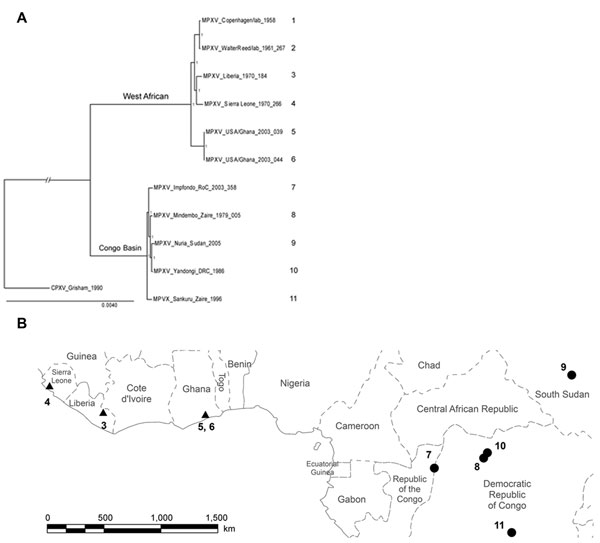Phylogenetic and Ecologic Perspectives of a Monkeypox Outbreak, Southern Sudan, 2005
Yoshinori Nakazawa

, Ginny L. Emerson, Darin S. Carroll, Hui Zhao, Yu Li, Mary G. Reynolds, Kevin L. Karem, Victoria A. Olson, R. Ryan Lash, Whitni B. Davidson, Scott K. Smith, Rebecca S. Levine, Russell L. Regnery, Scott A. Sammons, Michael A. Frace, Elmangory M. Mutasim, Mubarak E. M. Karsani, Mohammed O. Muntasir, Alimagboul A. Babiker, Langova Opoka, Vipul Chowdhary, and Inger K. Damon
Author affiliations: Author affiliations: Centers for Disease Control and Prevention, Atlanta, Georgia, USA (Y. Nakazawa, G. L. Emerson, D.S. Carroll, H. Zhao, Y. Li, M.G. Reynolds, K. L. Karem, V. A. Olson, R. R. Lash, W. B. Davidson, S. K. Smith, R. S. Levine, R. L. Regnery, S. A. Sammons, M.A. Frace, I.K. Damon); National Public Health Laboratory, Khartoum, Sudan (E.M. Mutasim, M.E.M. Karsani); Federal Ministry of Health, Khartoum (M.O. Muntasir, A.A. Babiker); World Health Organization Regional Office for the Eastern Mediterranean, Cairo, Egypt (M.L. Opoka); Médecins Sans Frontières, Khartoum (V. Chowdhary)
Main Article
Figure 1

Figure 1. . A) Phylogenetic tree produced from genome sequences (189,830 nt) of the 11 MPXV isolates. The separation between West African and Congo Basin clades is highly supported; the Sudan isolate is included within the Congo Basin clade. Posterior probabilities are indicated by the number 1 at each node. Scale bar indicates nucleotide substitutions per site. B) Map of geographic distribution of the isolates. Numbers correspond to those in Table 1; strains 1, Copenhagen 1958 and 2, Walter Reed 1961, were from laboratory samples and are not represented on the map. 3, Liberia 1970; 4, Sierra Leone 1970; 5, USA/Ghana 2003 039; 6, USA/Ghana 2003 044; 7, Impfondo 2003; 8, Mindembo 1979; 9, Nuria 2005; 10, Yandongi 1986; and 11, Sankuru 1996. Triangles indicate West African clade; circles indicate Congo Basin clade.
Main Article
Page created: January 22, 2013
Page updated: January 22, 2013
Page reviewed: January 22, 2013
The conclusions, findings, and opinions expressed by authors contributing to this journal do not necessarily reflect the official position of the U.S. Department of Health and Human Services, the Public Health Service, the Centers for Disease Control and Prevention, or the authors' affiliated institutions. Use of trade names is for identification only and does not imply endorsement by any of the groups named above.
